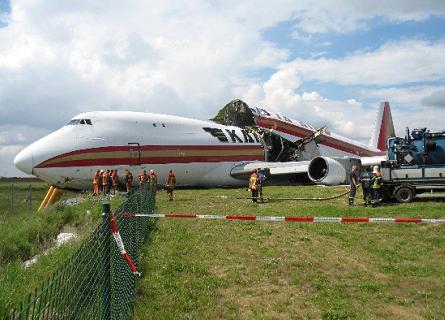US freighter operator Kalitta Air has adapted its training procedures to warn crews of the risk of post-V1 rejected take-off, following an inquiry into the overrun which destroyed a Boeing 747-200F in Brussels.
The aircraft experienced a stall in its inboard right-hand Pratt & Whitney JT9D engine after it ingested a kestrel during the take-off roll on 25 May last year. It failed to stop within the length of runway 20, travelling 300m (980ft) beyond and breaking up into several sections, although none of the five occupants was injured.
Belgian investigators believe several elements contributed to the crew's decision to abort the take-off despite the aircraft's travelling 12kt above V1. After hearing a bang the captain called 'reject', seven seconds after the first officer had made the V1 call-out.
 |
|---|
© Belgian Air Accident Investigation Unit |
The inquiry found that the Kalitta Air had suffered a number of engine incidents in the previous four years, including 12 on take-off - four of which involved N704CK, the aircraft lost at Brussels.
One of these incidents had been personally experienced by the captain of the crashed aircraft, during a departure at Seoul Inchon when the jet had yawed after a loud bang generated by an engine failure.
"The sound of the bang [at Brussels] could have given the pilot the impression it was caused by something worse than what happened in Inchon," says the Belgian Air Accident Investigation Unit in its final report.
It adds that perceptions over the runway could also have influenced the decision to reject the take-off. The take-off performance had been calculated for a wet runway, but the crew perceived it as looking dry.
"The state of the runway may have given the crew the impression they had a better take-off margin than originally computed," says the report. Crucially, while the computed margin was 300m, the line-up took place at an intersection, designated B1, which effectively shorted the available runway length and cut the margin to zero.
At the point where the bird ingestion and loss of engine power occurred, the slope of the runway increases, the report says: "Although not seen on the flight-data recorder, this might have given the pilot the impression the aircraft slowed down.
"In his statement [to the inquiry] the pilot said 'he was under the impression the aircraft could not fly' after he heard the bang."
Kalitta Air's general operational procedures state that pilots should not reject take-off after V1 unless the aircraft is uncontrollable. "Statistics indicate that rejected take-offs at V1 are very seldom successful," it adds.
The carrier requires thrust reversers to be deployed during a rejected take-off, but the crew of the 747 did not do so. The inquiry attempted to determine whether the spoilers were activated but the results were inconclusive.
Analysis by Boeing shows that the aircraft, which reached a speed of 152kt, could theoretically have stopped before the end of the 9,800ft runway - even without reverse thrust and spoilers - if it had been dry. But for a wet runway the aircraft would have overrun, even with reverse thrust and spoilers deployed.
Kalitta Air, in line with a recommendation from the inquiry, has modified its training programme to highlight the hazard of aborting take-off at speeds close to V1. This programme uses the Brussels accident to underline correct take-off rejection procedures.
Source: Air Transport Intelligence news























